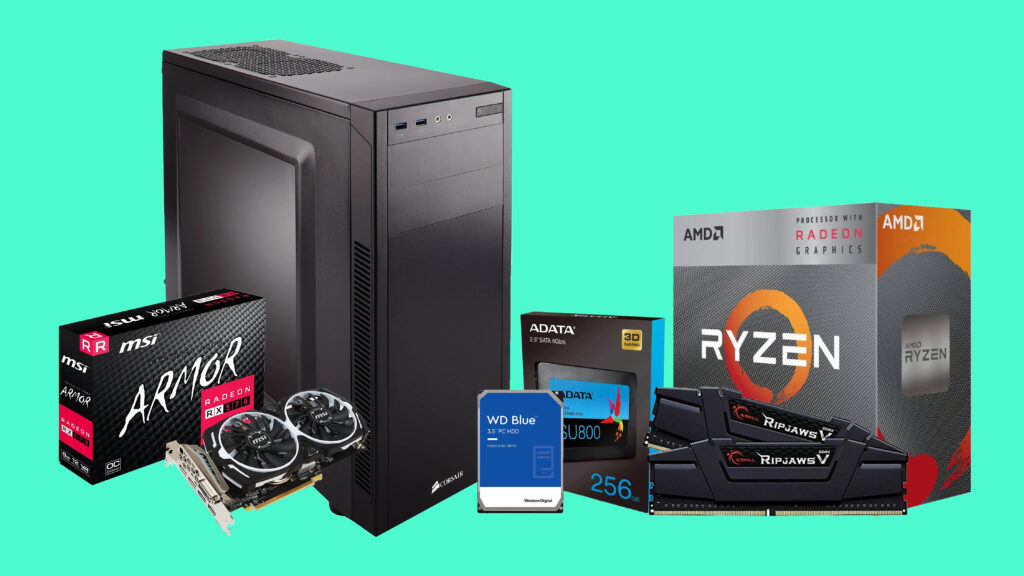Building a gaming PC doesn’t have to break the bank. With the right approach, you can assemble a machine capable of running your favorite games at decent settings without spending a fortune. This guide walks you through the essential components, tips, and tricks to help you build a budget gaming PC for less.
1. Set Your Budget
Before diving into components, decide how much you’re willing to spend. A realistic budget for a gaming PC can range between $500 and $1,000. While it’s possible to go lower, keep in mind that compromises will need to be made on performance or future upgradeability.
2. Choose Your Components Wisely
Your PC’s performance is determined by the components you choose. Let’s break it down:
a. Central Processing Unit (CPU)
- Recommendation: AMD Ryzen 5 5600G or Intel Core i3-12100F.
- Both offer excellent performance for gaming without overspending. The Ryzen 5 5600G even includes integrated graphics, which can be a temporary solution if you’re not ready to buy a dedicated GPU.
b. Graphics Processing Unit (GPU)
- Recommendation: NVIDIA GTX 1660 Super, AMD RX 6500 XT, or RTX 3050.
- Focus on mid-range GPUs that offer solid 1080p gaming performance. Consider buying used or refurbished GPUs for significant savings, but ensure the seller is reputable.
c. RAM (Memory)
- Recommendation: 16GB (2x8GB) DDR4 with at least 3200MHz speed.
- 16GB is the sweet spot for gaming. Faster RAM can slightly improve performance, especially with AMD processors.
d. Storage
- Recommendation: A combination of a 500GB SSD (for Windows and games) and a 1TB HDD (for other files).
- SSDs drastically improve loading times, making them essential for gaming PCs.
e. Motherboard
- Recommendation: Choose a B550 motherboard for AMD or a B660 motherboard for Intel.
- Look for features like M.2 SSD support, USB 3.0 ports, and Wi-Fi if you need it.
f. Power Supply Unit (PSU)
- Recommendation: 500-650W 80+ Bronze certified PSU.
- Avoid cheap, generic power supplies as they can risk damaging your components. Brands like Corsair, EVGA, or Seasonic are reliable.
g. Case
- Recommendation: A budget-friendly case like the Cooler Master MasterBox Q300L or NZXT H510.
- Ensure the case supports your motherboard size (ATX, Micro-ATX) and has adequate airflow.
3. Where to Save Money
Building on a budget often means finding areas to cut costs. Here’s how:
- Skip RGB Lighting: While it looks cool, RGB doesn’t improve performance.
- Go for Previous-Generation Parts: Older CPUs and GPUs often deliver excellent value.
- Use Stock Coolers: Many CPUs come with a decent stock cooler that’s sufficient for gaming.
- Buy Used or Refurbished: Check platforms like eBay, Craigslist, or Facebook Marketplace for second-hand components.
- Wait for Sales: Look for discounts during Black Friday, Cyber Monday, or seasonal sales.
4. Building Your PC
Building a PC is easier than it might seem. Follow these steps:
- Prepare Your Workspace: Ensure a clean, static-free environment.
- Install the CPU: Carefully align the CPU with the motherboard socket and secure it.
- Add RAM and Storage: Insert RAM sticks into their slots and attach your SSD/HDD.
- Mount the Motherboard: Screw the motherboard into the case using standoffs.
- Install the GPU: Insert the GPU into the PCIe slot and secure it.
- Connect the PSU: Attach power cables to the motherboard, GPU, and storage drives.
- Cable Management: Use zip ties or cable organizers to keep cables tidy.
- Power On and Test: Connect your monitor and peripherals, then boot up to BIOS.
5. Optimize Performance
Once your PC is built, take steps to optimize its performance:
- Install Windows or Linux: Windows 10/11 is the preferred OS for gaming, but Linux distros like Pop!_OS are great free alternatives.
- Update Drivers: Install the latest GPU and motherboard drivers for optimal performance.
- Tweak Graphics Settings: Adjust in-game settings to achieve the best balance between visuals and frame rates.
- Overclock Carefully: Slightly overclocking your CPU, GPU, or RAM can boost performance, but proceed cautiously and monitor temperatures.
6. Future-Proofing Tips
- Upgrade Path: Choose a motherboard that supports future CPU and RAM upgrades.
- Add More Storage: You can easily add additional SSDs or HDDs as your needs grow.
- Improve Cooling: Consider adding case fans or upgrading to an aftermarket cooler later.
7. Example Budget Builds
$500 Build
- CPU: AMD Ryzen 5 5600G (integrated graphics)
- RAM: 16GB DDR4 3200MHz
- Storage: 500GB SSD
- PSU: 500W 80+ Bronze
- Case: Budget ATX case
$750 Build
- CPU: Intel Core i3-12100F
- GPU: NVIDIA GTX 1660 Super
- RAM: 16GB DDR4 3200MHz
- Storage: 500GB SSD + 1TB HDD
- PSU: 600W 80+ Bronze
- Case: Cooler Master MasterBox Q300L
$1,000 Build
- CPU: AMD Ryzen 5 5600X
- GPU: NVIDIA RTX 3050
- RAM: 16GB DDR4 3600MHz
- Storage: 1TB NVMe SSD
- PSU: 650W 80+ Gold
- Case: NZXT H510
Building a budget gaming PC is a rewarding experience that offers great performance without emptying your wallet. By carefully selecting components, leveraging sales, and making smart compromises, you can create a powerful machine that handles modern games with ease. Start small, and remember—PC building is a journey. You can always upgrade as your budget allows!




